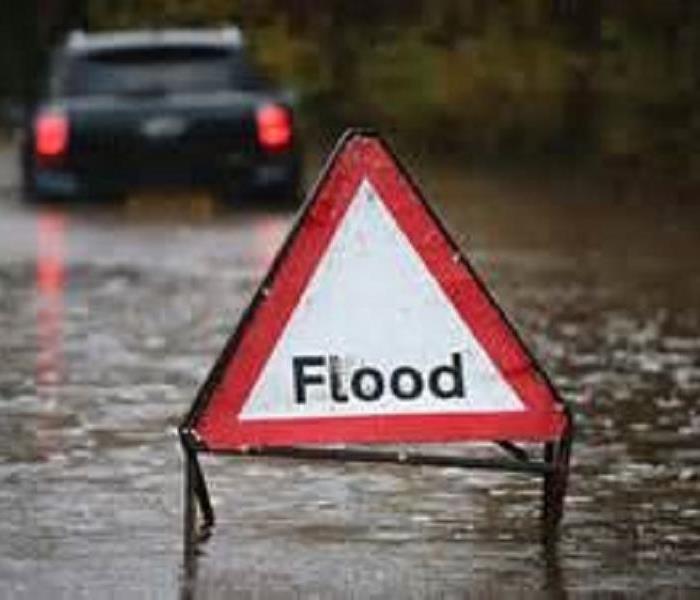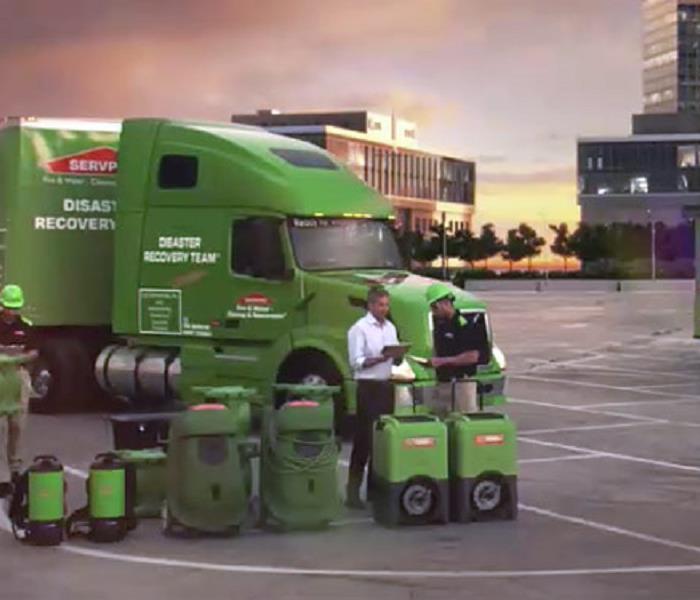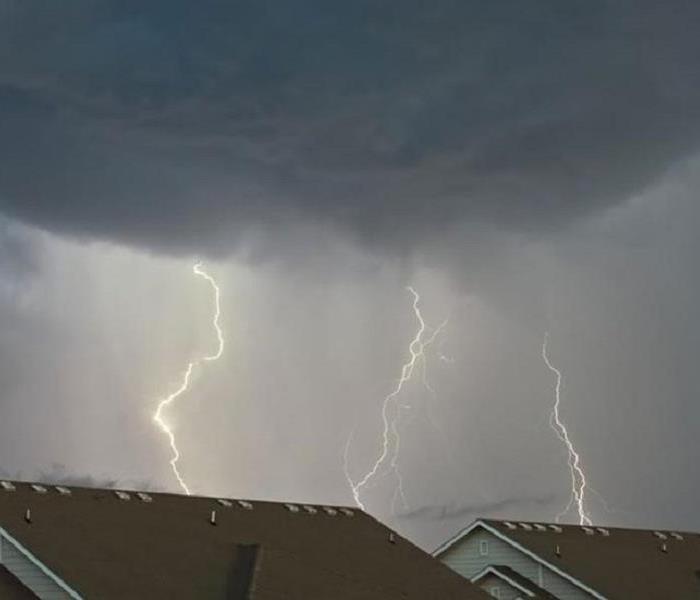Archived Storm Damage Blog Posts
Storm Safety Tips
9/1/2017 (Permalink)
Storm-Safety TipsNo matter where you live, you'll encounter storms. Most of the time these are routine, but some cause serious and dangerous problems. Here are tips for preparing for storms, and weathering them safely.
- Always keep a battery-powered radio in your home so that you can tune to radio stations if you lose electricity. Check or change the batteries frequently.
- Keep a flashlight in an easily accessible spot on every floor of your home. Check the batteries monthly, and replace them as needed.
- Keep a supply of candles on hand for power failures.
- As a safety precaution before leaving the house on vacation, unplug all electrical appliances except for those lights connected to automatic timers.
- If you live in a storm-prone area, nail down roof shingles or use adequate adhesive to keep them from blowing off in a violent wind. For roofs with shingles that are not the seal-down type, apply a little dab of roofing cement under each tab.
- A lightning-protection system should offer an easy, direct path for the bolt to follow into the ground and thus prevent injury or damage. Grounding rods (at least two for a house) should be placed at opposite corners of the house.
- Don't go out during a hurricane unless you have to; however, if flooding threatens, seek high ground, and follow the instructions of civil defense personnel.
- When a major storm is imminent, close shutters, board windows, or tape the inside of larger panes with an "X" along the full length of their diagonals. Even a light material like masking tape may give the glass the extra margin of strength it needs to resist cracking.
When a tornado threatens, leave windows slightly ajar.
- The basement is not a good shelter during a tornado -- it's too close to gas pipes, sewer pipes, drains, and cesspools. A better shelter would be underground, far from the house (in case the roof falls) and away from the gas and sewer systems. Let all family members know where the shelter is.
- Keep an eye on large trees -- even healthy ones -- that could damage your house if felled in a storm. Cut them back, if necessary.
We've covered numerous key tips for preparing for storms and getting through them safely. Now you can regard gathering clouds with a little less trepidation.
What Kind of Damage Can Standing Water Cause?
9/1/2017 (Permalink)
What Kind of Damage Can Standing Water Cause?A few inches of standing water may look like a small problem, but it can be deceptively dangerous, whether it is inside or outside of your home. While you may only see damage that is caused on the surface, like paint or carpet damages, the water that seeps under the surface is capable of causing more serious damage if it isn’t properly removed and dried out. Read on to learn more about the kinds of damage standing water can cause to your home and property.
Exterior Property Damages Standing water on the exterior of the property can cause problems in many ways, regardless of whether it comes from an excessive amount of rain, a pipe leak or a sewage backup. However, the source of the water can make a large difference as far as the type of damage it will cause to your property. Standing rainwater can contain pieces of debris, bacteria and chemicals from pest control. Left to accumulate, this water can damage grass and landscaping features, as well as eating away at the roots of the trees that are nearby.
Any type of water can seep into the foundations of your home, and if left long enough, can soak through the foundation into the floors. This causes a sort of pervasive damage to the foundations because it rots away the material from the inside out. The damage from this can appear years in the future as the foundation erodes and the home shifts as a result, or cracks appear in the foundation.
Interior Property Damages The risks standing water poses inside your home are similar to those posed to the exterior, but more severe. Whether the water comes from a sewage backup, water leak or outdoor flooding that seeps in, it can pose damage to the structure of your home, including walls, floors and carpets. The additional issue posed inside your home is, of course, mold. The longer water is allowed to seep into the textiles of your home, the harder it will be to properly dry out the items and the greater the chance for eventual mold growth.
If the water that floods your home comes from a sewage backup, the chance of bacteria being present becomes much greater. Even water that looks clean can contain bacteria that are invisible to the naked eye. However, even clean water will draw bacteria if it is allowed to stand in your home. The associated smell may be difficult to remove from the structure of your home and your furniture, and may even require expert restoration in order to be returned to normal.
Depending on the cause of the water that floods your home and whether it is covered, all of the damage and restoration needed may be covered by your homeowner’s insurance policy.
Thunderstorms and Lightning
8/29/2017 (Permalink)
Thunderstorms & Lightning
All thunderstorms are dangerous. Every thunderstorm produces lightning. While lightning fatalities have decreased over the past 30 years, lightning continues to be one of the top three storm-related killers in the United States. On average in the U.S., lightning kills 51 people and injures hundreds more. Although most lightning victims survive, people struck by lightning often report a variety of long-term, debilitating symptoms.
Other associated dangers of thunderstorms include tornadoes, strong winds, hail and flash flooding. Flash flooding is responsible for more fatalities – more than 140 annually – than any other thunderstorm-associated hazard. Dry thunderstorms that do not produce rain that reaches the ground are most prevalent in the western United States. Falling raindrops evaporate, but lightning can still reach the ground and can start wildfires.
Before Thunderstorm and Lightning
To prepare for a thunderstorm, you should do the following:
- To begin preparing, you should build an emergency kit and make a family communications plan.
- Remove dead or rotting trees and branches that could fall and cause injury or damage during a severe thunderstorm.
- Postpone outdoor activities.
- Secure outdoor objects that could blow away or cause damage.
- Get inside a home, building, or hard top automobile (not a convertible). Although you may be injured if lightning strikes your car, you are much safer inside a vehicle than outside.
- Remember, rubber-soled shoes and rubber tires provide NO protection from lightning. However, the steel frame of a hard-topped vehicle provides increased protection if you are not touching metal.
- Shutter windows and secure outside doors. If shutters are not available, close window blinds, shades or curtains.
- Unplug any electronic equipment well before the storm arrives.
How to Prepare for Floods
6/24/2016 (Permalink)
 Be prepared for a flood.
Be prepared for a flood.
SERVPRO Corporation has a long standing partnership with the Red Cross. We hope that the below information helps you to be prepared for any flooding that might affect you.
Floods are among the most frequent and costly natural disasters. Conditions that cause floods include heavy or steady rain for several hours or days that saturates the ground. Flash floods occur suddenly due to rapidly rising water along a stream or low-lying area.
You will likely hear weather forecasters use these terms when floods are predicted in your community:
•Flood/Flash Flood Watch—Flooding or flash flooding is possible in your area.
•Flood/Flash Flood Warning—Flooding or flash flooding is already occurring or will occur soon in your area.
Prepare
How to Prepare for a Flood
You’ll be better prepared to withstand a flood if you have the following items available – packed and ready to go in case you need to evacuate your home
•Water—at least a 3-day supply; one gallon per person per day
•Food—at least a 3-day supply of non-perishable, easy-to-prepare food
•Extra batteries
•First Aid Kit
•Medications (7-day supply) and medical items (hearing aids with extra batteries, glasses, contact lenses, syringes, cane)
•Multi-purpose tool
•Sanitation and personal hygiene items
•Copies of personal documents (medication list and pertinent medical information, deed/lease to home, birth certificates, insurance policies)
•Cell phone with chargers
•Family and emergency contact information
•Extra cash
•Emergency blanket
•Map(s) of the area
•Baby supplies (bottles, formula, baby food, diapers)
•Pet supplies (collar, leash, ID, food, carrier, bowl)
•Tools/supplies for securing your home
•Extra set of car keys and house keys
•Extra clothing, hat and sturdy shoes
•Rain gear
•Insect repellent and sunscreen
•Camera for photos of damage
Respond
Responding Appropriately During a Flood
•Listen to area radio and television stations and a NOAA Weather Radio for possible flood warnings and reports of flooding in progress or other critical information from the National Weather Service (NWS)
•Be prepared to evacuate at a moment’s notice.
•When a flood or flash flood warning is issued for your area, head for higher ground and stay there.
•Stay away from floodwaters. If you come upon a flowing stream where water is above your ankles, stop, turn around and go another way. Six inches of swiftly moving water can sweep you off of your feet.
•If you come upon a flooded road while driving, turn around and go another way. If you are caught on a flooded road and waters are rising rapidly around you, get out of the car quickly and move to higher ground. Most cars can be swept away by less than two feet of moving water.
•Keep children out of the water. They are curious and often lack judgment about running water or contaminated water.
•Be especially cautious at night when it is harder to recognize flood danger.
•Because standard homeowner’s insurance doesn’t cover flooding, it’s important to have protection from the floods associated with hurricanes, tropical storms, heavy rains and other conditions that impact the U.S. For more flood safety tips and information on flood insurance, please visit the National Flood Insurance Program Web site at www.FloodSmart.gov.
Recover
Flood Recovery Tips
•Return home only when officials have declared the area safe.
•Before entering your home, look outside for loose power lines, damaged gas lines, foundation cracks or other damage.
•Parts of your home may be collapsed or damaged. Approach entrances carefully. See if porch roofs and overhangs have all their supports.
•Watch out for wild animals, especially poisonous snakes that may have come into your home with the floodwater.
•If you smell natural or propane gas or hear a hissing noise, leave immediately and call the fire department.
•If power lines are down outside your home, do not step in puddles or standing water.
•Keep children and pets away from hazardous sites and floodwater.
•Materials such as cleaning products, paint, batteries, contaminated fuel and damaged fuel containers are hazardous. Check with local authorities for assistance with disposal to avoid risk.
•During cleanup, wear protective clothing, including rubber gloves and rubber boots.
•Make sure your food and water are safe. Discard items that have come in contact with floodwater, including canned goods, water bottles, plastic utensils and baby bottle nipples. When in doubt, throw it out!
•Contact your local or state public health department to see if your water supply might be contaminated. You may need to boil or treat it before use. Do not use water that could be contaminated to wash dishes, brush teeth, prepare food, wash hands, make ice or make baby formula!
When Storms or Floods hit Southern Scioto & Lawrence Counties, SERVPRO is ready!
4/26/2016 (Permalink)
 Our highly trained crews are ready to respond 24/7 to storm or flood damage in Southern Scioto & Lawrence Counties.
Our highly trained crews are ready to respond 24/7 to storm or flood damage in Southern Scioto & Lawrence Counties.
SERVPRO of Southern Scioto & Lawrence Counties specializes in storm and flood damage restoration. Our crews are highly trained and we use specialized equipment to restore your property to its pre-storm condition.
Faster Response
Since we are locally owned and operated, we are able to respond quicker with the right resources, which is extremely important. A fast response lessens the damage, limits further damage, and reduces the restoration cost.
Resources to Handle Floods and Storms
When storms hit Southern Scioto & Lawrence Counties, we can scale our resources to handle a large storm or flooding disaster. We can access equipment and personnel from a network of 1,650 Franchises across the country and elite Disaster Recovery Teams that are strategically located throughout the United States.
http://www.SERVPROsouthernsciotolawrencecounties.com/storm-flooding-restoration
Have Storm or Flood Damage? Call Us Today 1-740-532-9210





 24/7 Emergency Service
24/7 Emergency Service

